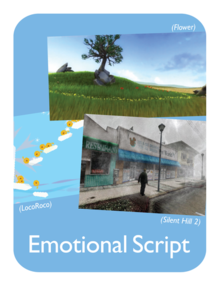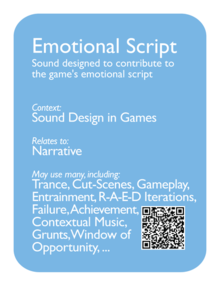Difference between revisions of "Emotional Script"
ValterAlves (Talk | contribs) m |
ValterAlves (Talk | contribs) m |
||
| Line 18: | Line 18: | ||
See the [[Talk:Emotional Script| discussion]], about the name | See the [[Talk:Emotional Script| discussion]], about the name | ||
| description = | | description = | ||
| − | A game "experience" is built upon the memory of the emotions | + | A game "experience" is built upon the memory of the emotions the player experimented. To optimize the emotional relevance of every moment the player is interacting with the game product an Emotional Script ought to be thoughtfully designed. |
Sound explorations hold great potential in the design of the [[Emotional Script]]. | Sound explorations hold great potential in the design of the [[Emotional Script]]. | ||
Revision as of 21:10, 18 October 2011

|

| |
| The card's front face | The card's back face |
Synopsis
| Sound designed to contribute to the game’s emotional script. |
Relationships
Context:
Sound Design in Games ![]() .
.
Relates to:
Narrative ![]() .
.
May use many, including:
Trance ![]() , Cut-Scenes File:M385px-Cut-Scenes-front-v20.png, Gameplay File:M385px-Gameplay-front-v20.png, Entrainment
, Cut-Scenes File:M385px-Cut-Scenes-front-v20.png, Gameplay File:M385px-Gameplay-front-v20.png, Entrainment ![]() , R-A-E-D Iterations
, R-A-E-D Iterations ![]() , Failure
, Failure ![]() , Achievement
, Achievement ![]() , Contextual Music
, Contextual Music ![]() , Grunts
, Grunts ![]() , Window of Opportunity
, Window of Opportunity ![]() , ....
, ....
Description
A game "experience" is built upon the memory of the emotions the player experimented. To optimize the emotional relevance of every moment the player is interacting with the game product an Emotional Script ought to be thoughtfully designed.
Sound explorations hold great potential in the design of the Emotional Script.
In addition to the exploration this pattern suggests, we address some other design patters which may also contribute to the Emotional Script:
Examples
External Resources
References to the importance of emotions in human performance






